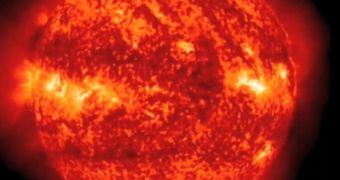A group of experts has recently managed to conclude a new project, which revolved around turning data on solar winds into music, or an acoustical representation of the regular graphs, charts and numbers. The goal of this investigation is to discover information that could otherwise get lost in the crowd, and to provide experts with a new angle in analyzing some of the most important manifestations of our Sun. Solar winds are currently the target of many investigations, as the phenomena can have significant implications for our livelihood, if they hit our planet with more energy than usual.
The new approach was developed by specialists at the University of Michigan, who were led by recent School of Music alumnus Robert Alexander. He explains that wind speed and particle density data are the most likely to escape scientific scrutiny, as investigators peer over numbers and charts produced based on them. For the new system, he used data collected by the American space agency's Advanced Composition Explorer satellite, which is always aimed at the flux of highly-charged particles coming in from the Sun. Solar winds manifest themselves more during solar maximums, the peak-activity periods of the 11-year cycle the Sun undergoes, PhysOrg reports.
This is not the first research ever to deal in translating datasets into sounds. This is the basic operating principle of the Geiger counter, for example. This radiation detector basically detects high-energy particles, and then emits audible clicks as their quantity increases. “What makes this project different is the level of artistic license I was given,” Alexander says, adding that the end result is somewhere “in between art and science.” He reveals that the notes sound somewhat primal and otherwordly, as one would expect. “Every piece of scientific data tells a story. I'm expressing this story through music. These sonifications present scientific data in a way that is immediately visceral,” the expert adds.
“In this sonification, we can actually hear in the data when the temperature goes up, or when the density increases,” says UM Department of Atmospheric, Oceanic and Space Sciences research fellow Jason Gilbert. He adds that studies of solar winds could allow astronomers and astrophysicists to gain a better ability to predict how these phenomena will behave over time. “I am excited for sonification’s potential in research, but I think more work will need to be done to realize that potential,” concludes research computer specialist Jim Raines, who works at the same Department.

 14 DAY TRIAL //
14 DAY TRIAL //